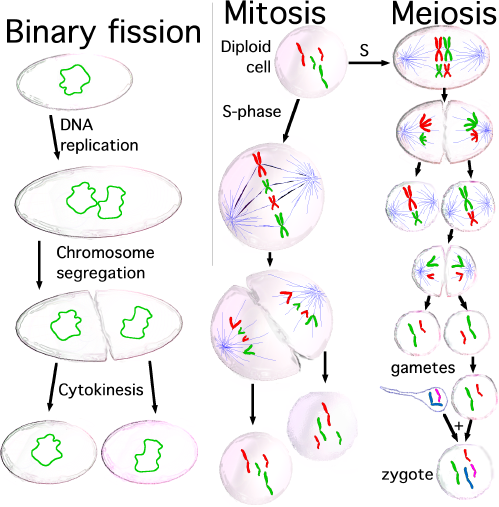
PUMPA - SMART LEARNING
எங்கள் ஆசிரியர்களுடன் 1-ஆன்-1 ஆலோசனை நேரத்தைப் பெறுங்கள். டாப்பர் ஆவதற்கு நாங்கள் பயிற்சி அளிப்போம்
Book Free DemoSignificance of meiosis:
- Among the sexually reproducing organisms, each species' constant chromosome number is maintained by this division.
- Due to crossing over, it increases the genetic variability in organisms' population from onegeneration to the next.
Note: Genetic variations are essential for the process of evolution.
Difference between mitosis and meiosis:
Properties | Mitosis | Meiosis |
Type of cells | It takes place in somatic cells. | It takes place in reproductive cells. |
Number of division | Single division | Two divisions |
Growth and formation | Involved in growth and the division and occurs continuously throughout life. | Involved in gamete formation only during the reproductively active age. |
Synapsis of homologous chromosomes | It does not occur | In prophase I, crossing over occurs between the non-sister chromatids of chromosomes. |
Genetic composition | Genetically identical daughter cells are formed. | Daughter cells are genetically not similar to the parent cell and are randomly assorted. |
Number of daughter cells | Two diploid daughter cells are formed. | Four haploid daughter cells are formed. |
Chromosome number | The chromosome number present in the daughter cell is similar to the parent cell (2n). | The chromosome number present in the daughter cell is just half (n) of the parent cell. |

Difference between binary fission, mitosis and meiosis
Stem cell:
- They are special human cells, and they are undifferentiated cells that undergo unlimited divisions and give rise to many different types of cells.
- Embryonic stem cells differentiate into differenttissues and organs.
- Stem cells are used in the treatment of certain degenerative diseases such as parkinson's and Alzheimer's.
- In present days umbilical cord blood is collected at the time of childbirth and is being stored in stem cell banks to treat any diseases in the future.
Reference:
https://upload.wikimedia.org/wikipedia/commons/f/f9/Three_cell_growth_types.png